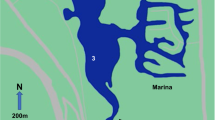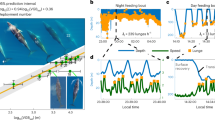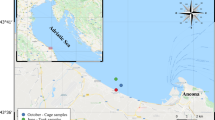Abstract
Rows of comb-like or tufted gill rakers in the oral cavity of suspension-feeding fishes (for example, herring, anchovies and tilapia) have been thought to serve as (1) non-porous barriers that direct particle-laden water to the sticky oral roof, where particles are retained as water exits from the oral cavity, (2) conventional dead-end filters that sieve particles from water exiting between rakers, or (3) sticky filters that retain particles encountered by a hydrosol filtration mechanism1,2,3,4,5,6. Here we present data from computational fluid dynamics and video endoscopy in suspension-feeding fish indicating that the rakers of three distantly related species function instead as a crossflow filter7,8. Particles are concentrated inside the oral cavity as filtrate exits between the rakers, but particles are not retained on the rakers. Instead, the high-velocity crossflow along the rakers carries particles away from the raker surfaces and transports the particles towards the oesophagus. This crossflow prevents particles from clogging the gaps between the rakers, and solves the mystery of particle transport from the rakers to the oesophagus.
This is a preview of subscription content, access via your institution
Access options
Subscribe to this journal
Receive 51 print issues and online access
$199.00 per year
only $3.90 per issue
Buy this article
- Purchase on Springer Link
- Instant access to full article PDF
Prices may be subject to local taxes which are calculated during checkout



Similar content being viewed by others
References
Kardong, K. V. Vertebrates: Comparative Anatomy, Function, Evolution 2nd edn (McGraw-Hill, Boston, 1998).
Gerking, S. D. Feeding Ecology of Fish (Academic, San Diego, 1994).
Vogel, S. Life in Moving Fluids: The Physical Biology of Flow 2nd edn (Princeton Univ. Press, Princeton, 1994).
Hoogenboezem, W. et al. A new model of particle retention and branchial sieve adjustment in filter-feeding bream (Abramis brama, Cyprinidae). Can. J. Fish. Aquat. Sci. 48, 7–18 (1991).
Sanderson, S. L. et al. Mucus entrapment of particles by a suspension-feeding tilapia (Pisces: Cichlidae). J. Exp. Biol. 199, 1743–1756 (1996).
Sanderson, S. L., Cech, J. J. Jr & Patterson, M. R. Fluid dynamics in suspension-feeding blackfish. Science 251, 1346–1348 (1991).
Belfort, G., Davis, R. H. & Zydney, A. L. The behavior of suspensions and macromolecular solutions in crossflow microfiltration. J. Membr. Sci. 96, 1–58 (1994).
Zeman, L. J. & Zydney, A. L. Microfiltration and Ultrafiltration: Principles and Applications (Dekker, New York, 1996).
Cheer, A. Y. L. & Koehl, M. A. R. Paddles and rakes: fluid flow through bristled appendages of small organisms. J. Theor. Biol. 129, 17–39 (1987).
Koehl, M. A. R. in Biological Fluid Dynamics, Soc. Exp. Biol. Symp. Vol. 49 (eds Ellington, C. P. & Pedley, T. J.) 157–182 (Company of Biologists, London, 1995).
Sanderson, S. L. & Cheer, A. Y. in Fluid Dynamics in Biology (eds Cheer, A. Y. & van Dam, C. P.) 135–160 (American Mathematical Society, Providence, 1993).
Shimeta, J. & Jumars, P. A. Physical mechanisms and rates of particle capture by suspension-feeders. Oceanogr. Mar. Biol. Annu. Rev. 29, 191–257 (1991).
LaBarbera, M. Feeding currents and particle capture mechanisms in suspension feeding animals. Am. Zool. 24, 71–84 (1984).
Goodrich, J. S., Sanderson, S. L., Batjakas, I. E. & Kaufman, L. S. Branchial arches of suspension-feeding Oreochromis esculentus: sieve or sticky filter? J. Fish Biol. 56, 858–875 (2000).
Li, H., Fane, A. G., Coster, H. G. L. & Vigneswaran, S. Direct observation of particle deposition on the membrane surface during crossflow microfiltration. J. Membr. Sci. 149, 83–97 (1998).
Chellam, S. & Wiesner, M. R. Particle back-transport and permeate flux behavior in crossflow membrane filters. Environ. Sci. Technol. 31, 819–824 (1997).
Wiesner, M. R. Morphology of particle deposits. J. Environ. Eng. 125, 1124–1132 (1999).
Porter, M. C. Concentration polarization with membrane ultrafiltration. Ind. Eng. Chem. Prod. Res. Develop. 11, 234–248 (1972).
Green, G. & Belfort, G. Fouling of ultrafiltration membranes: lateral migration and the particle trajectory model. Desalination 35, 129–147 (1980).
Sethi, S. & Wiesner, M. R. Modeling of transient permeate flux in cross-flow membrane filtration incorporating multiple particle transport mechanisms. J. Membr. Sci. 136, 191–205 (1997).
Tardieu, E., Grasmick, A., Geaugey, V. & Manem, J. Hydrodynamic control of bioparticle deposition in a MBR applied to wastewater treatment. J. Membr. Sci. 147, 1–12 (1998).
Bowen, W. R. & Jenner, F. Theoretical descriptions of membrane filtration of colloids and fine particles: an assessment and review. Adv. Colloid Interface Sci. 56, 141–200 (1995).
Drew, D. A., Schonberg, J. A. & Belfort, G. Lateral inertial migration of a small sphere in fast laminar flow through a membrane duct. Chem. Eng. Sci. 46, 3219–3224 (1991).
Lauder, G. V. The suction feeding mechanism in sunfishes (Lepomis): an experimental analysis. J. Exp. Biol. 88, 49–72 (1980).
Norton, S. F. & Brainerd, E. L. Convergence in the feeding mechanics of ecomorphologically similar species in the Centrarchidae and Cichlidae. J. Exp. Biol. 176, 11–29 (1993).
Cheryan, M. Ultrafiltration and Microfiltration Handbook (Technomic, Lancaster, 1998).
Mummert, J. R. & Drenner, R. W. Effect of fish size on the filtering efficiency and selective particle ingestion of a filter-feeding clupeid. Trans. Am. Fish. Soc. 115, 522–528 (1986).
Langeland, A. & Nøst, T. Gill raker structure and selective predation on zooplankton by particulate feeding fish. J. Fish Biol. 47, 719–732 (1995).
Gibson, R. N. Development, morphometry and particle retention capability of the gill rakers in the herring, Clupea harengus L. J. Fish Biol. 32, 949–962 (1988).
Acknowledgements
We are grateful to J. Perkins, S. Yu, J. Wagner, S. Leman, J. Yang, C. Chesnutt and B. Rourke for assistance with data collection and analysis; G. Belfort, E. L. Brainerd, M. Patterson and M. Wiesner for comments on the manuscript; H. Austin, P. Geer, J. Goins, T. Mathes, J. Owens, M. Roberts, P. Sadler, Z. Stroud, J. Viehweg and M. A. Vogelbein for assistance in specimen collection and care; B. Bunting and H. Burrell for figure preparation; and K. Wiencek for technical advice. This work was supported by grants from the NSF (S.L.S., A.Y.C.) and the US Department of Energy (A.Y.C.), corporate gifts from Eastman Kodak Company and Peak Performance Technologies (S.L.S.), and research leave from the College of William and Mary (S.L.S.).
Author information
Authors and Affiliations
Corresponding author
Rights and permissions
About this article
Cite this article
Sanderson, S., Cheer, A., Goodrich, J. et al. Crossflow filtration in suspension-feeding fishes. Nature 412, 439–441 (2001). https://doi.org/10.1038/35086574
Received:
Accepted:
Issue Date:
DOI: https://doi.org/10.1038/35086574
This article is cited by
-
Morphological comparison of the detailed structure of gill rakers from three different feeding habits of marine fish species
Zoomorphology (2023)
-
The orobranchial structures in four neotropical silversides (Teleostei: Atherinopsidae) related with feeding habits
Zoomorphology (2019)
-
A microfluidic pore model to study the migration of fine particles in single-phase and multi-phase flows in porous media
Microsystem Technologies (2018)
-
Not-so-simple sieving by ascidians: re-examining particle capture at the mesh and organismal scales
Marine Biology (2018)
-
Eco-evolution in size-structured ecosystems: simulation case study of rapid morphological changes in alewife
BMC Evolutionary Biology (2017)
Comments
By submitting a comment you agree to abide by our Terms and Community Guidelines. If you find something abusive or that does not comply with our terms or guidelines please flag it as inappropriate.





